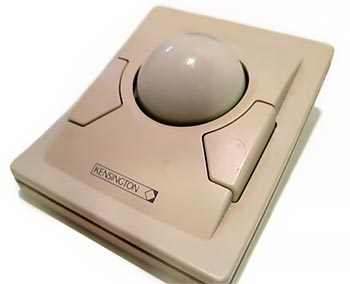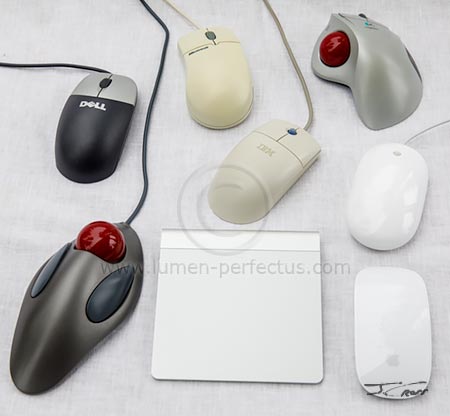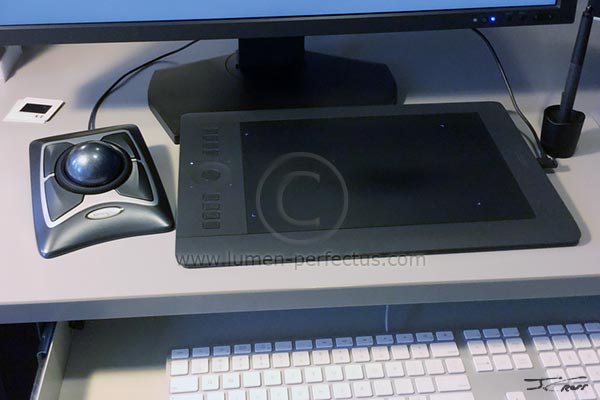www.lumen-perfectus.com
Pointing the Way
“If ease of use was the only requirement, everybody would still be riding tricycles.”
Douglas Engelbart, inventor of the mouse (along with William English)
For several decades the mouse has been an integral part of computer use. The prevalence today of laptop computers and the variety of devices with touch screens, all of which can function at least tolerably well without a mouse, has surely reduced its ubiquity, but for those of us still using computers on the desktop, the mouse or some other type of pointing device remains necessary.
In my “professional” working life I sat in front of a computer monitor, keyboard, and mouse since the 1980s. (I'm happy to forget working years earlier with pre-mouse systems on which the lack of a mouse was the least of my worries.) The basic mouse has evolved in many ways since Engelbart and English invented it in the 1960's: movement/position sensing technologies; button count (zero to too many); wired and wireless; attempts at improving ergonomics resulting in an amazing array of shapes and sizes; scrolling methods; battery or light powered or rechargeable; multi-color backlights; surely much more. Some of this led to improvement, some didn't, but in most cases one still pushes the thing around on a surface to move a pointer on the monitor.
There are also variations one can't really call mice (I'll stick with that; you can substitute “mouses” as the plural if you like), things like trackpads, trackballs, and digitizing tablets, plus weirder things like eye-tracking and even direct mind control. Except for those last two, I've tried just about all of them.
Past Perfect Pointing
I'd call my first encounter with a computer mouse, on an Apple Macintosh in 1984, surprising and impressive. That mouse, a large, blocky thing with a large, blocky button, moved the pointer around the Mac's nine-inch black-and-white CRT with a speed and accuracy we quickly learned to take for granted. Its ergonomics left a lot to be desired, and the large weighted ball collected lint and gunk like politicians collect NRA money. A new industry spawned overnight: mousepads. CLI (Command Line Interface) computer geeks hated mice (and the Mac). The rest of us loved it, adapted quickly, and never looked back.

My first non-mouse, the Kensington Turbo Mouse, circa 1992 (screen grab from a YouTube video).
Pat and I bought our first Mac, an SE, in 1988. Since the 1984 version the included mouse hadn't seen much revision; it got a color change and a lower profile but was otherwise much like the original. A few years later I bought a Mac IIsi, which included the same mouse. About that time I decided to try something new, the Kensington “Turbo Mouse” which, despite its name, wasn't a mouse at all, but a trackball, a stationary base with a large top-side ball and two buttons. I liked it. Being a stationary device, unlike a mouse it didn't require much desk space, and the large ball could be rolled quickly with the palm or “flicked” with the fingers, or it could be rolled in precise, tiny amounts with one or two fingers. I put away the original mouse and never used it again with that computer.
In late 1998 I replaced that Mac with a PC from IBM with the then-new Windows 98 OS. As you'd expect, the IBM had no ADB (Apple Desktop Bus) connections as required by the Turbo Mouse; I retired that to my Closet of Obsolete Technologies, and I missed it. The PC came with an IBM-branded mouse, a pretty ordinary mechanical device with a rounded shape, a weighted ball, and IBM's trademark, weird scrolling nub which looked a lot like the eraser on a #2 pencil. I learned to live with that, but never really got used to it nor learned to control scrolling with any accuracy.
Keeping Track
The IBM got passed on to my wife (Pat), when I bought a generic Windows XP computer in the fall of 2001. The included mechanical mouse was notable for its terrible design. Crummy, lightweight materials and construction didn't make up for that, resulting in an unusable mouse. Instead I used a Microsoft “IntelliMouse” two-button mechanical mouse with a scroll wheel. Perfectly fine, unremarkable. Around this time I treated myself, for my daily work computer, to a wireless, optical Logitech Cordless Trackman Wheel trackball. This oddly-shaped two-button device could only be used with the right hand (also true of the IntelliMouse), had a vertical scroll wheel and a much smaller ball than the Turbo Mouse, and a hockey-puck-like receiver to connect to the computer's USB port. The trackball required a AA battery, which powered the thing for six months or so. The included driver software displayed the battery level. Optical sensors read the movement of the ball, making very rare the need for cleaning. After acclimating for a week or so I found the Trackman to be comfortable and functional. Pat hated it. She also wasn't keen on the IBM mouse, so we got another Trackman, this the two-button wired (USB) version with no scroll wheel; it's called the Trackman Marble and is still available for purchase. It's a symmetrical device, suitable for either the right or left hand. Pat used it for years, on the IBM, on the Dell computer that replaced it, and later on her MacBook Pro (used in a dock on the desktop with external monitor and keyboard). I found it frustrating to use because it lacked a scroll wheel.

Most of the pointing devices I've used. Clockwise from top: Microsoft IntelliMouse, IBM mouse, Logitech Cordless Trackman Wheel, Apple Mighty Mouse, Apple Magic Mouse, Apple Magic TrackPad, Logitech Trackman Marble, Dell optical mouse.
For a number of years my “work” computers were from Dell. When ordering those I specified Dell's optical mouse. These slightly tear-drop shaped mice, while fairly generic, seemed perfect. They fit my hand, they were perfectly weighted, the optical sensor in the base rarely needed cleaning, and they had a vertical scroll wheel between the two buttons. I continued to use the Logitech Cordless Trackman Wheel, but kept a Dell mouse connected for use with the left hand, switching between them frequently to help relieve RSI shoulder pain.
In 2008 I ended my use of Windows machines, getting the Mac Pro I still use every day for my photography work. The Mac came with Apple's wired “Mighty Mouse.” Its shape and size aren't remarkable, but it provided my first experience with a tiny, pea-sized scroller ball. It allows both vertical and horizontal scrolling in very fine increments. Although I tried other pointing devices on this Mac, I never removed the Mighty Mouse. Among those other devices: the Cordless Trackman (but by then constant use with the right hand had become problematic for me); Apple's cordless, touch-sensitive Magic Mouse (just plain terrible); and Apple's Magic TrackPad, which I loved. For some time that, plus the Mighty Mouse on the left, seemed the perfect combination. But when I got the awkwardly-named Wacom Intuos Pro Touch Medium tablet, which does everything the Magic TrackPad does and more, the smaller device moved to the closet. I used the Wacom for casual cursor movement via touch and for precision work with its stylus, and kept the old Mighty Mouse on the left for general computing. It's still my favorite mouse, but I've used it up; after over ten years of use it is simply falling apart. This led to the search for a replacement.
To The Point
One can still find new stock of the discontinued Mighty Mouse, so while that remained an option, I investigated other devices. I had only two criteria: I wanted a wired device so there'd be no screwing around with batteries or charging, and I wanted to use it under my left hand. These narrowed my choices considerably. I got lucky and stumbled upon a Trackpads and Mice discussion on MacInTouch (scroll down to entry #15 for a good starting point). This continues for several pages and as usual for MacInTouch provides some excellent insight and advice. I followed the MacInTouch thread for a month. I then decided to return to the past and get the current equivalent of my very first trackball; today that's Kensington's Expert Mouse, which still isn't a mouse. Its form-factor is nearly identical to the Turbo Mouse I used nearly 30 years ago; it now also includes a large, soft wrist rest. The Expert Mouse has four buttons and a large scroll ring surrounding the ball. The driver software allows customizing the functions of the buttons and ring. My initial impression wasn't entirely favorable, but I've now used it a little over a month, tinkered several times with the customization settings, and got through a short break-in period such that its operation is much smoother than the first couple of days. Overall, in combination with the Wacom tablet I'm liking it and not missing the old Magic Mouse.

My current compliment of input devices, Apple Wired Keyboard with Numeric Keypad, Wacom Intous Pro Touch Medium and stylus, and the Kensington Expert Mouse.
The choice of pointing device is largely a matter of personal preference; you might love yours while someone else hates the same one, and you might change your preference over time, as Pat did. She now uses the Cordless Trackman Wheel on her Mac (which, as mentioned, she disliked some years ago). We're both productive and happy with these devices, which is, after all, the point.
May, 2018
All products and brand names mentioned are trademarks or registered trademarks of their respective owners.
I've no affiliation with any except as a customer.